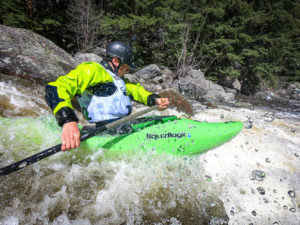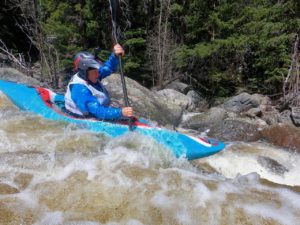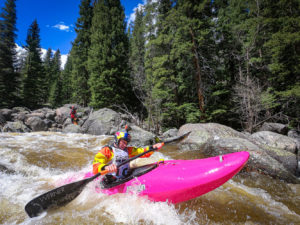Posted by: Katie Coakley
As rapids change, so do the kayakers who take them on
By Shauna Farnell

In any outdoor sport, athletes have to forge ahead through changing weather and conditions. For kayakers, when water levels change – especially in what is perennially the most challenging category of whitewater – it can make for an entirely new playing field.
If there were any token, athletic quality needed to navigate Thursday’s Steep Creek Championship successfully, it was adaptability.
Leading into the 2019 race, which takes kayakers down a steep and narrow quarter-mile stretch of Class V rapids on Homestake Creek, everyone was anticipating high, smooth water pouring off of the peaks after the extraordinary snow season. Instead, low temperatures and continued snowfall at high elevations meant a slow runoff: Until just a day or two before the race, Homestake was so low it was nearly impossible to paddle.
But following a beautiful evening and sunny morning of rapidly warming temperatures leading up to Thursday’s race, the water reached a level of about 100 cubic feet per second (CFS), which, depending on who you talked to, made it either perfect or perfectly pinball-y.
“It’s more pushy than it was yesterday, but less pushy than it would be the year we had 650 (CFS). That year, you just hoped and prayed you stayed straight. Today, it’s perfect, not too bony, not too pushy. I would say this is the perfect level,” said Adriene Levknecht, who ended up winning Steep Creek for the first time since 2011.
Arguably more familiar with Homestake Creek than any other athlete in the international field of competitors, Levknecht, 30, is not exactly in love with the thing.

“This is 12 years here and it doesn’t get any easier. Your chances of messing up are still the same,” she said. “It’s not the type of whitewater that we’re going to say, OK, we’re going to go have a great day on the water.
“It’s a quarter mile of just … sh*t: pin rocks, swim potential … it’s everything. You have to roll with the punches. You have to deal with that random rock you didn’t see. You have to deal with one thing after another. Kayakers are really good at that. We’re really good at being adaptable and working around getting screwed.”
Not everyone managed the workaround. Thursday’s race saw plenty of swimmers after boats capsized and racers were spun off of their lines. Luckily, all walked away relatively unscathed.
“In the grand scheme of things, a lot of people will try to avoid rivers like this because it tries to break your boat; or, if you’re upside down, it’s going to suck; or, there are places to get stuck on rocks,” said Dane Jackson, who won his second straight Steep Creek Championship Thursday, having won in 2017 before last year’s race was moved to Dowd Chute due to low water. “But for a race, that’s what makes it so much fun. It’s manky, which basically means you’re going down the river and you’re either bouncing off a lot of rocks or avoiding them at all costs. Steep Creek right now is the definition of manky.”
Dane’s sister and fellow kayak champion Emily Jackson opted out of Thursday’s race because while she’s proven her worth in a wide gamut of water levels and conditions, she simply didn’t want to sign up for the rapid gear shifting necessary this time around.
“I always feel strongest when I can practice on something that’s a little more consistent, so with the way the snow was melting this year and a combination of other factors, the practice wasn’t there,” Emily said from the bank, where she was cheering on her brother. “You can break equipment or yourself even. For someone who’s not able to watch or see it, it would be the equivalent of a pinball machine. You can just go downstream and float and be calm, but a creek like this is much more like a pinball machine in the sense that you’re literally going from feature to feature, rock to rock, bouncing back and forth and just trying to keep the boat floating downstream, which is hard to do.”

“I did like 14 laps yesterday, but you can do as many laps as you want, it doesn’t really prepare you for if the water’s higher,” Dane added. “You’ve just got to be ready.”
Argentina’s Valentin Guitierrez was competing in his first Steep Creek competition (notching an impressive fourth-place finish) and said “a lot” of adjustments were required for navigating the water on Thursday compared to his practice runs the day before.
“To be at the top level, you really have to watch out how the water moves, how strong it is, how strong it pushes you right or left,” he said. “We woke up today and did a couple laps. I had big mistakes this morning because I had to adjust. You have to react quickly, super fast.”
Silverthorne resident (via Buffalo, NY) Peter Farmelo also got his first taste of Steep Creek Thursday, coming in with only two practice runs.
“A lot of the rocks are covered that we were hitting and banging down yesterday, so as long as you’re in the main flow, it’s faster and less abusive on your body, your boat and your paddle,” he said. “The water is definitely moving faster, so you have less time to clean up any mistakes. But at any water level, there’s going to be people having weird lines, people going upside down, people swimming. This is Class V steep creek. There’s a chance for something to happen any time.”
France’s Marlene Devillez, one of only five women to enter the race, ended up third after runner up Darby McAdams, despite a crash and swim in her third and final run. Just before that run, she, along with the other women in the race, served as rescuers for her compatriot Capucine Thomas Lepine, who took a frightening spill in her first run, her boat floating bottom up for several seconds before pinning underwater.
“When we go on a river like this, we analyze all the lines. There is a true risk to roll and to swim but it’s why we do this, because when you find a sick line, it’s just awesome,” Devillez said.
Share this Story:






















